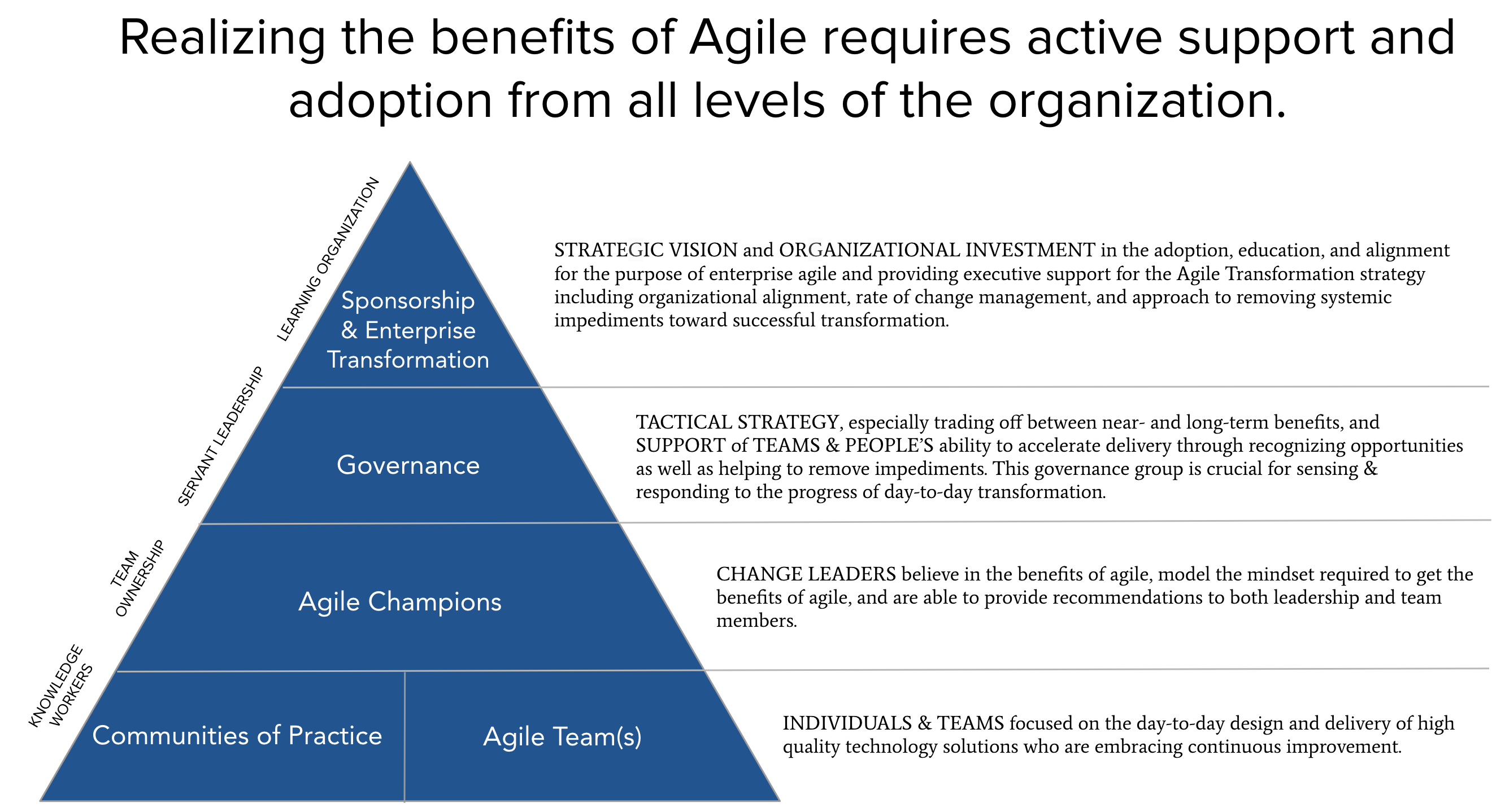A Lightweight Model for Real Change at All Levels of an Organization
In the past two decades, 75% of companies worldwide have tried to gain the advantages of agility – primarily, acceleration of speed-to-market. The ability to accelerate the delivery of products and services is dependent on many internal and external variables, and more importantly the combination of those variables which can interact in complicated and systemic ways.
Some examples of those variables are:
- the balance of market research and sales on a product portfolio strategy
- the technological capability to adapt to new requests
- the need to incorporate new technology while maintaining current offerings
- the ability to scale including ever-evolving roles & responsibilities
These organizational variables are systemic, and balancing them - that is, adopting agile - is much more difficult than simply writing user stories. It’s no wonder that 70% of transformations fail.
Agile transformation requires optimizing the organization as a whole. Not just piecemeal practices like writing user stories.
Many attempts at Agile Transformation approaches are unidirectional, whether they are full-on top-down organizational change or bottom-up team-level training. Top-down Enterprise Agile often involves standardizations of a popular agile or lean framework, a tool that works for some teams and not for others, and a new role that holds people accountable. Bottom-up team training starts out mimicking agile practices blindly rather than understanding the purpose. For instance, this often involves breaking work into smaller pieces focusing on functional contribution, not deliverable value and having two team meetings – one that sounds like a justification of yesterday’s efforts and one that generally devolves into predicting the future by way of estimating the time it takes to complete work. Even if these teams are just going through the motions of agility, what generally results is an uncomfortable awareness: there are unresolved systemic issues within the organization as a whole. Agile transformation makes these systemic issues evident. Therefore, the optimal acceleration of agile requires top-down and bottom-up support.
Common pitfalls of agile transformation:
Pitfall 1: Organizations believe that “self-organizing teams” are responsible for driving all the change, often without support.
Advice: Working and thinking differently occurs at all levels of an organization, including leadership and strategy, portfolio management and product roadmapping, and refactoring your codebase to accommodate new features. Even self-organizing teams are teams within an organization – a system that requires coordination at a minimum. Self-organizing doesn’t mean flying solo.
Pitfall 2: Change Management initiatives and rhetoric are often rooted in concepts and abstractions that are disconnected from the work.
Advice: Adopting Agile requires consistent, concrete change management. Even basic Agile practices like smaller cross-functional teams, collaborative specification, and continuous improvement, require an explicit opportunity to change. Transformative change presents itself through intentional, evaluative experience and experimentation–trying things and seeing what works best. This results in getting real feedback, working new ways, learning new things.
Pitfall 3: Organizations assume that Agile frameworks do all the work and fix all the impediments.
Advice: Agile isn’t a one size fits all. Agile will make evident what slows down an organization’s ability to increase its speed-to-market. If done right, not only will the challenges be evident, but the options to adjust will also be evident. (Often through knowledge workers and meaningful metrics.) Optionality is a competitive advantage that agile presents - it does not replace the brainpower and the courage to choose an option.
Accelerating Agile adoption requires a bidirectional approach to optimize for the organization as a whole.
Given that transformation involves change, organizations need a holistic structure that embraces that change. Here’s a governance model that maximizes the bidirectional communication to align and accelerate day-to-day (tactical) work with organizational (strategic) goals, which is the point of agile.

A governance model like this provides a structure that facilitates momentum. When done well it creates the organizational safety for an experiential mindset, which reveals opportunities that accelerate agile. Self-organizing teams require focused feedback loops and support from change leaders and leadership to align on acceptable constraints (that impede acceleration). Leaders need to consider optionality, enabling aligned actions that balance organizational constraints with speed-to-market. This allows for decisions and tradeoffs to be made safely at every level of the organization. Being directionally aligned consistently, choosing acceptable impediments, and taking action requires discipline that isn’t learned overnight. To accelerate agile, organizations first and foremost need to standardize the values and principles (the why and what), not the tactical execution (the how).
Accelerating agile is a journey that requires commitment, patience, and a healthy amount of pragmatism.
Whatever method of agile you choose whether it be top-down, bottom-up, or some combination, consider your environment–your teams, your organization, your customers, and the products and services that unites you all together. Moving together isn’t easy, but what we know for sure is that if nothing changes nothing changes! So we still must try! I hope this helps :)
References
The Standish Group Chaos Report 2015
McKinsey. A Conversation with Harry Robinson: Why do most transformations fail. 10 July 2019
TechBeacon. Survey: Is Agile the New Norm?
CollabNet VersionOne. State of Agile.
Gothelf, Jeff and Seiden, Josh. Sense and Respond: How Successful Organizations Listen to Customers and Create New Products Continuously. 2017.
Heath, Chip and Health, Dan. Switch: How to Change Things when Change is Hard. 2010.




